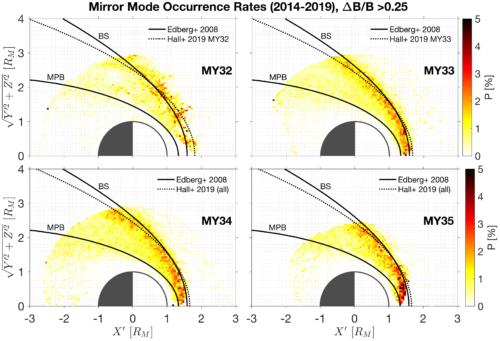On Mirror Mode Waves at Mars: Results from MAVEN
- 1Space Research Institute (IWF), Austrian Academy of Sciences, Graz, Austria (cyril.simon.wedlund@gmail.com)
- 2Institut de Recherche en Astrophysique et Planétologie (IRAP), Toulouse, France
- 3Instituto de Geofísica, Universidad Nacional Autónoma de México, Coyoacán, Mexico
- 4NASA Goddard Space Flight Center, Laboratory for Planetary Magnetospheres, Greenbelt, MD, USA
- 5Department of Physics and Astronomy, University of Iowa, Iowa City, IA, US
Mirror mode (MM) structures have been evidenced everywhere in solar system plasmas, from the solar wind to Earth, Mars and Venus, as well as comets. MM waves are low-frequency long-wavelength transverse waves, usually linearly polarised and non-propagating in the plasma rest frame. In the data they commonly appear as sudden dips or peaks in the magnetic field intensity, anti-correlated with plasma density variations. They grow in a high-β plasma from an ion temperature anisotropy itself triggered by any asymmetry upstream in the solar wind flow, or typically as a result of the crossing of a quasi-perpendicular bow shock.
We present here statistical maps of MM waves detected by magnetic-field-only measurements as observed by the NASA/MAVEN spacecraft and its fluxgate magnetometer MAG. Candidate detections are validated against high-cadence plasma moments given by the Solar Wind Ion Analyzer (SWIA) to yield the best set of B-field-only criteria. We examine the dependence of these MM structures on Martian Year (MY, see figure), season (solar longitude Ls) and solar activity (EUV flux). They appear to be bound by the bow shock on one side and by the magnetic pile-up boundary on the other. Occurrence probability is less than 6% on average at any time. Distribution qualitatively agrees with previous studies with a smaller data subset.

The figure shows B-field-only candidate detections for MM waves at Mars, MY32 to MY35 (with ΔB/B ≥ 0.25, and the angles to the minimum/maximum variance direction ΦminV ≥ 80° and ΘmaxV ≤ 20°).
How to cite: Simon Wedlund, C., Volwerk, M., Mazelle, C., Möstl, C., Rojas-Castillo, D., Espley, J., and Halekas, J.: On Mirror Mode Waves at Mars: Results from MAVEN, Europlanet Science Congress 2020, online, 21 September–9 Oct 2020, EPSC2020-777, https://doi.org/10.5194/epsc2020-777, 2020

